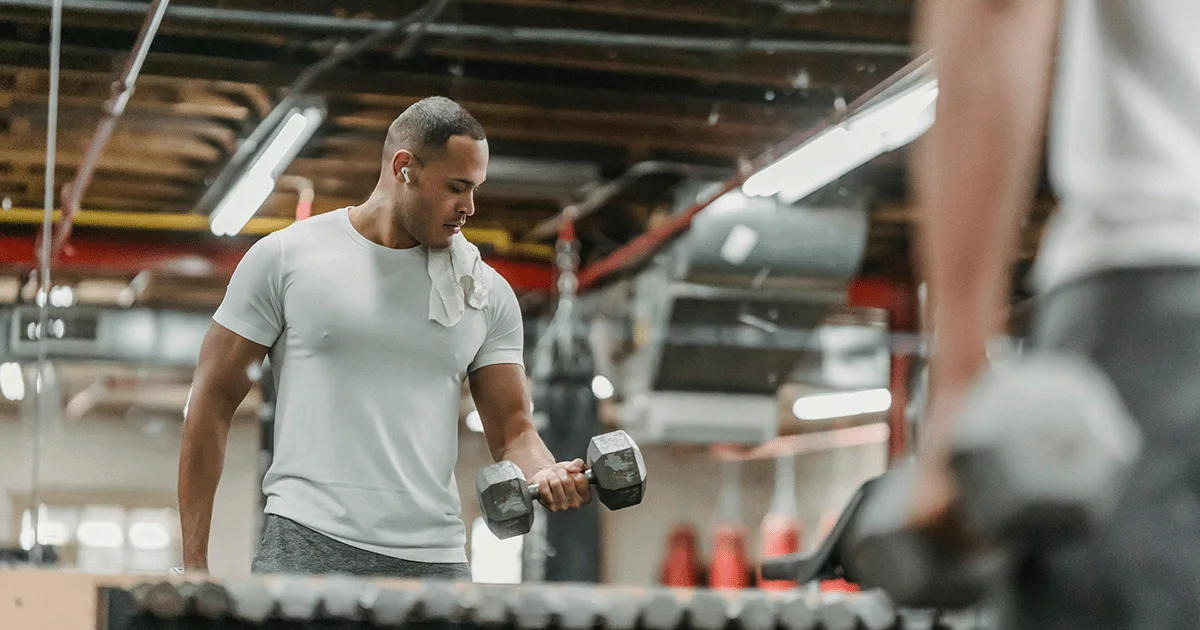Here's what we'll cover
Here's what we'll cover
Here's what we'll cover
“Bulking” is a bodybuilding term. It means you’re eating certain foods in a caloric surplus to add weight and mass while building muscle (Iraki, 2019). Lean bulking—also called “clean bulking”—is an approach to bulking that aims to increase lean body mass while minimizing added body fat.
If all you care about is packing on mass—be it fat or muscle—then you can eat pretty much whatever you want. But if your goal is to get big without much fat gain, then lean bulking is for you.
What is lean bulking?
All forms of bulking require that the person eat more calories than they burn (Iraki, 2019). The goal of lean bulking is to add muscle but not a lot of body fat. You can achieve this through a specialized, targeted diet (Garthe, 2018).
Lean bulking vs. dirty bulking
Unlike lean bulking, dirty bulking is all about adding weight. It often involves cramming your diet with high-calorie foods that are traditionally thought to be unhealthy in order to gain weight quickly.
What are the benefits of lean bulking?
Even if you’re training hard, the quality of your diet still matters to your overall health.
While you may be able to gain muscle and stay fit with a do-it-yourself diet, eventually, a poor or unbalanced approach to bulking will catch up with you (Della Guardia, 2015).
Not only is lean bulking a safer, healthier approach to getting bigger, but it also produces better long-term results. Compared to a control group that was allowed to eat whatever they wanted to build mass, study participants who were given nutritional guidance when bulking saw an increase in lean body mass one year after the study concluded. The control group did not (Garthe, 2018).
How to start lean bulking
If you want to add weight, you must maintain a positive energy balance—aka, a calorie surplus. That means your daily calorie intake needs to exceed your daily energy expenditure (Iraki, 2019).
Online calculators, like this one from the American Council on Exercise, are helpful to figure out how many calories you burn each day. They can help you determine the number of calories you need to eat to maintain your current weight.
You probably want to pack on mass as quickly as possible. But if you aim to add muscle, not fat, a slow-and-steady approach may be optimal. Research has found that adding between 0.25 and 0.5 kg (or about 0.5 to 1 pounds) per week is a good goal. To hit that mark, aim to eat 10% to 20% more calories than you need to maintain your current weight (Iraki, 2019).
Your lean bulking meal plan
It’s helpful to build your lean bulking diet around proteins, carbohydrates, and fats, otherwise known as the three primary “macro” (macronutrient) groups.
Protein for lean bulking
The amino acids in protein stimulate muscle growth and help prevent muscle breakdown. That’s why protein-rich foods and supplements are a staple of any bodybuilder’s diet. Especially if you’re lean bulking, research has found that getting extra calories from protein can help you pack on lean muscle (Churchward-Venne, 2013).
When you’re mapping out your meals, start by planning your protein intakes. Every day, your goal is to get 15% to 25% of your calories from protein. To do that, you want to consume large amounts of protein—approximately 1.8 to 3 grams of protein per kilogram of body weight (g/kg/day) (Churchward-Venne, 2013).
Within that daily range, research on bodybuilders suggests that 2.2 g/kg/day may be ideal for maximizing muscle gains (Morton, 2018). For a 180-pound person, that works out to roughly 178 g of protein every day.
Some examples of high-protein foods include (Bradlee, 2017):
Meats, such as beef, lamb, and pork
Poultry, such as chicken and turkey
Fish
Dairy (milk, yogurt, cheese)
Legumes (beans and peanuts), soy, nuts, and seeds
Protein powders or supplements, such as whey protein shakes
Try to spread out your protein intake throughout the day (Iraki, 2019).
Carbohydrates for lean bulking
For people trying to bulk up, carbs are a must. Fruits, vegetables, and other carbohydrate-rich foods support the body’s micronutrient needs and help regulate some important hormones (Iraki, 2019). There’s also evidence that people who adopt low-carb diets lose muscle mass even if they strength train (Vargas, 2018).
Carbs should make up the most significant part of your diet—somewhere around 50% of your daily calories. At this level, research suggests you’ll optimize both your training performance and mass gains (Lima-Silva, 2013).
Some examples of carbohydrate-rich foods are (Englyst, 2007):
Fruits
Vegetables
Starchy vegetables, such as sweet potatoes
Whole-grain foods, such as quinoa or whole-grain pasta
Your goal is to eat 3-5 g/kg/day of carbohydrates (Iraki, 2019).
Fats for lean bulking
Many dietary fats provide essential nutrients—meaning your body needs them. Also, very low-fat diets have been linked to a drop in testosterone levels, limiting performance and muscle gains.
However, the research on dietary fat is all over the place. There’s some indication that high-fat diets may be problematic for bodybuilders even if those fats are "healthy" (Iraki, 2019).
For now, your best approach to fat intake is a Goldilocks plan—not too much and not too little. Aim to get 20% to 35% of your daily calories from fat (Iraki, 2019; ADA, 2009). That typically works out to roughly 0.5 to 1.5 g/kg/day.
Some examples of dietary fats include (Liu, 2017):
Olive oil
Avocado
Nuts and seeds
Fatty fish, such as salmon, herring, mackerel, and sardines
Peanut butter and nut butters
Dairy products, such as cheese, milk, butter, and Greek yogurt
Lean bulking: foods to avoid
Unlike a dirty bulk, where “clean eating” isn’t a priority, during a lean or “clean” bulk, it’s best to avoid heavily processed or packaged foods. Not only do ultra-processed foods lead to poor health outcomes, but they can lead to unwanted fat gain—something you want to avoid when lean bulking (Monteiro, 2009).
Tips for lean bulking
You’ve probably heard a lot about protein timing. This refers to eating protein at certain times of the day—like before, during, or post-workout—to encourage muscle growth.
But when it comes to packing on lean mass, a recent review found that timing protein intake with training doesn’t really matter. You need to eat enough protein. But getting it at mealtimes is just as effective as consuming it when you workout (Hudson, 2018).
You also want to make sure you’re eating a variety of foods—especially fruits and vegetables. Doing this will ensure you satisfy all your body’s nutrient needs (Iraki, 2019).
Adding mass and bulk doesn’t mean you have to add a lot of body fat if that's not your goal. Lean bulking, done right, can help you put on weight safely.
DISCLAIMER
If you have any medical questions or concerns, please talk to your healthcare provider. The articles on Health Guide are underpinned by peer-reviewed research and information drawn from medical societies and governmental agencies. However, they are not a substitute for professional medical advice, diagnosis, or treatment.
References
American Dietetic Association, Dietitians of Canada, American College of Sports Medicine, Rodriguez, N. R., Di Marco, N. M., & Langley, S. (ADA). (2009). American College of Sports Medicine position stand. Nutrition and athletic performance. Medicine and Science in Sports and Exercise, 41 (3), 709–731. doi: 10.1249/MSS.0b013e31890eb86. Retrieved from https://pubmed.ncbi.nlm.nih.gov/19225360/
Bradlee, M. L., Mustafa, J., Singer, M. R., & Moore, L. L. (2017). High-Protein Foods and Physical Activity Protect Against Age-Related Muscle Loss and Functional Decline. The Journals of Gerontology. Series A, Biological Sciences and Medical Sciences, 73 (1), 88–94. doi: 10.1093/gerona/glx070. Retrieved from https://pubmed.ncbi.nlm.nih.gov/28549098/
Churchward-Venne, T. A., Murphy, C. H., Longland, T. M., & Phillips, S. M. (2013). Role of protein and amino acids in promoting lean mass accretion with resistance exercise and attenuating lean mass loss during energy deficit in humans. Amino Acids, 45 (2), 231–240. doi: 10.1007/s00726-013-1506-0. Retrieved from https://pubmed.ncbi.nlm.nih.gov/23645387/
Della Guardia, L., Cavallaro, M., & Cena, H. (2015). The risks of self-made diets: the case of an amateur bodybuilder. Journal of the International Society of Sports Nutrition, 12,
doi: 10.1186/s12970-015-0077-8. Retrieved from https://pubmed.ncbi.nlm.nih.gov/25908930/
Englyst, K. N., Liu, S., & Englyst, H. N. (2007). Nutritional characterization and measurement of dietary carbohydrates. European journal of clinical nutrition, 61 Suppl 1, S19–S39. doi: 10.1038/sj.ejcn.1602937. Retrieved from https://pubmed.ncbi.nlm.nih.gov/17992185/
Garthe, I., Raastad, T., & Sundgot-Borgen, J. (2018). Long-term effect of nutritional counselling on desired gain in body mass and lean body mass in elite athletes. Applied physiology, nutrition, and metabolism = Physiologie appliquee, nutrition et metabolisme, 36 (4), 547–554. doi: 10.1139/h11-051. Retrieved from https://pubmed.ncbi.nlm.nih.gov/21851204/
Hudson, J. L., Bergia, R. E. III, & Campbell, W. W. (2018) Effects of protein supplements consumed with meals, versus between meals, on resistance training-induced body composition changes in adults: a systematic review. Nutrition Reviews, 76 (6):461-468. doi: 10.1093/nutrit/nuy012. Retrieved from https://pubmed.ncbi.nlm.nih.gov/29697807/
Iraki, J., Fitschen, P., Espinar, S., & Helms, E. (2019). Nutrition Recommendations for Bodybuilders in the Off-Season: A Narrative Review. Sports (Basel, Switzerland), 7 (7), 154. doi: 10.3390/sports7070154. Retrieved from https://pubmed.ncbi.nlm.nih.gov/31247944/
Lima-Silva, A. E., Pires, F. O., Bertuzzi, R., Silva-Cavalcante, M. D., Oliveira, R. S., Kiss, M. A., & Bishop, D. (2013). Effects of a low- or a high-carbohydrate diet on performance, energy system contribution, and metabolic responses during supramaximal exercise. Applied physiology, nutrition, and metabolism = Physiologie appliquee, nutrition et metabolisme, 38 (9), 928–934. doi: 10.1139/apnm-2012-0467. Retrieved from https://pubmed.ncbi.nlm.nih.gov/23905657/
Liu, A. G., Ford, N. A., Hu, F. B., Zelman, K. M., Mozaffarian, D., & Kris-Etherton, P. M. (2017). A healthy approach to dietary fats: understanding the science and taking action to reduce consumer confusion. Nutrition Journal, 16 (1). doi: 10.1186/s12937-017-0271-4. Retrieved from https://pubmed.ncbi.nlm.nih.gov/28854932/
Monteiro, C. A. (2009). Nutrition and health. The issue is not food, nor nutrients, so much as processing. Public Health Nutrition, 12 (5), 729–731. doi: 10.1017/S1368980009005291. Retrieved from https://pubmed.ncbi.nlm.nih.gov/19366466/
Morton, R. W., Murphy, K. T., McKellar, S. R., Schoenfeld, B. J., Henselmans, M., Helms, E., et al. (2018). A systematic review, meta-analysis and meta-regression of the effect of protein supplementation on resistance training-induced gains in muscle mass and strength in healthy adults. British Journal of Sports Medicine, 52 (6), 376–384. doi: 10.1136/bjsports-2017-097608. Retrieved from https://bjsm.bmj.com/content/52/6/376.abstract
Vargas, S., Romance, R., Petro, J. L., Bonilla, D. A., Galancho, I., Espinar, S., Kreider, R. B., & Benítez-Porres, J. (2018). Efficacy of ketogenic diet on body composition during resistance training in trained men: a randomized controlled trial. Journal of the International Society of Sports Nutrition, 15 (1), 31. doi: 10.1186/s12970-018-0236-9. Retrieved from https://pubmed.ncbi.nlm.nih.gov/29986720/










